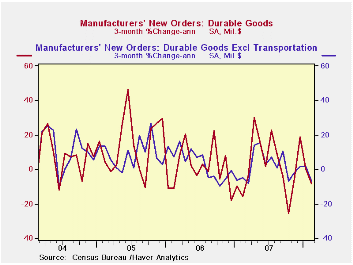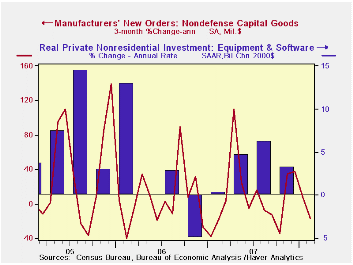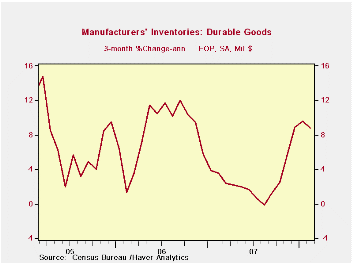 Global| Mar 26 2008
Global| Mar 26 2008U.S. Durable Goods Orders Post Surprising Decline
by:Tom Moeller
|in:Economy in Brief
Summary
New orders for durable manufactured goods fell 1.7% last month. During January orders declined 4.7% and that was slightly less severe than originally reported. Consensus expectations had been for a slight uptick in February orders. [...]

New orders for durable manufactured goods fell 1.7% last month. During January orders declined 4.7% and that was slightly less severe than originally reported. Consensus expectations had been for a slight uptick in February orders. Weakness in factory orders initially was suggested by the Institute for Supply Management's orders index which at 49.1 in February remained below the breakeven level of 50.
Excluding the volatile transportation sector, durable goods orders fell 2.6% after a 1.0% January decline that was slightly shallower than initially estimated.
Orders for transportation equipment rose a modest 0.6% after the 12.8% January slump. New orders for aircraft & parts recovered 5.1% (22.8% y/y) after a 30.7% January collapse but orders for motor vehicles parts fell 2.7% (-7.7% y/y). Orders for nondefense aircraft rose 5.4% following a 30.3% January drop.
Despite the rise in aircraft orders, orders for nondefense capital goods fell 1.0% after a little revised 8.4% January swoon . During the last ten years there has been an 80% correlation between the y/y gain in nondefense capital goods orders and the rise in equipment & software spending in the GDP accounts. The correlation with capital goods shipments is, as one would expect, a larger 92%.
February orders for nondefense capital goods less aircraft fell 2.6% following a 1.8% January decline that was deeper than initially estimated.

Orders for machinery fell a hard 13.3% (+0.7% y/y) following a modest 0.4% January uptick.Computers & related products orders, however, made up most of the prior month's decline with a 10.0% increase. Orders for communications equipment also recovered but only by 6.0% after a 14.1% January drop. Primary metal orders rose 1.0% and essentially repeated a 0.9% January increase.
Overall shipments of durable goods gave back all of the January increase with a 2.8% decline last month. That was led by a 4.1% drop in shipments from the transportation sector. Less transportation, shipments were weak and fell 2.3% (+3.1% y/y).
Inventories of durable goods rose 0.5% (4.1% y/y) and they have been building at an accelerated rate during the last few months. Annualized, an 8.8% rate of accumulation during those three months is up from -0.1% last August. Less transportation, inventories rose at a 4.7% rate during the last three months and that was raised from -0.6% last Summer.
| NAICS Classification | February | January | Y/Y | 2007 | 2006 | 2005 |
|---|---|---|---|---|---|---|
| Durable Goods Orders | -1.7% | -4.7% | 2.2% | 0.9% | 6.3% | 9.9% |
| Excluding Transportation | -2.6% | -1.0% | 1.6% | 0.2% | 7.6% | 8.8% |
| Nondefense Capital Goods | -1.0% | -8.4% | 6.9% | 3.5% | 10.6% | 17.1% |
| Excluding Aircraft | -2.6% | -1.8% | 4.7% | -1.6% | 8.5% | 11.1% |
Tom Moeller
AuthorMore in Author Profile »Prior to joining Haver Analytics in 2000, Mr. Moeller worked as the Economist at Chancellor Capital Management from 1985 to 1999. There, he developed comprehensive economic forecasts and interpreted economic data for equity and fixed income portfolio managers. Also at Chancellor, Mr. Moeller worked as an equity analyst and was responsible for researching and rating companies in the economically sensitive automobile and housing industries for investment in Chancellor’s equity portfolio. Prior to joining Chancellor, Mr. Moeller was an Economist at Citibank from 1979 to 1984. He also analyzed pricing behavior in the metals industry for the Council on Wage and Price Stability in Washington, D.C. In 1999, Mr. Moeller received the award for most accurate forecast from the Forecasters' Club of New York. From 1990 to 1992 he was President of the New York Association for Business Economists. Mr. Moeller earned an M.B.A. in Finance from Fordham University, where he graduated in 1987. He holds a Bachelor of Arts in Economics from George Washington University.






